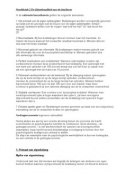Samenvatting
Summary CIE Physics A2 Paper 4 Notes
- Vak
- Instelling
[The note has been updated for syllabus]. All the questions in the past exam papers were analysed and there were a large amount of repetitive questions; the most noticeable ones being the definitions and the topic of ultrasound. For ultrasound this note consists of all the possible question and...
[Meer zien]












